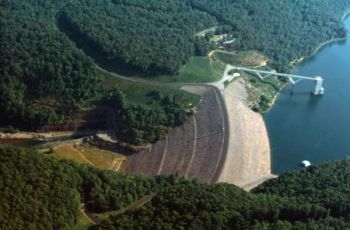Purposes of Dams: Difference between revisions
From ASDSO Dam Safety Toolbox
No edit summary |
No edit summary |
||
| Line 14: | Line 14: | ||
|caption= | |caption= | ||
<!-- Add picture caption --> | <!-- Add picture caption --> | ||
Gathright Dam in Virginia ([https://en.wikipedia.org/wiki/Gathright_Dam Wikipedia]) | Gathright Dam in Virginia | ||
(Image Source: [https://en.wikipedia.org/wiki/Gathright_Dam Wikipedia]) | |||
}} | }} | ||
Revision as of 14:50, 18 July 2023
Dams serve a variety of purposes including water storage, flood protection, power generation, tailings storage, or recreation. The design of a dam is heavily influenced by its intended purpose; however, the purpose and hazard classification of a dam can change over the course of its design life due to changing water needs, and changes in the surrounding community or in site conditions. No matter the purpose of a dam, safety to the public is the number one priority over any potential benefits. Common purposes for which dams are constructed include the following:

|
| Gathright Dam in Virginia
(Image Source: Wikipedia) |
- Power Generation
- Water Supply & Regulation
- Recreation
- Flood Risk Management
- Irrigation
- Navigation
- Waste Management
- Environment
Best Practices Resources
![]() Hydrologic Engineering Requirements for Reservoirs (EM 1110-2-1420), USACE
Hydrologic Engineering Requirements for Reservoirs (EM 1110-2-1420), USACE
Revision ID: 7282
Revision Date: 07/18/2023
